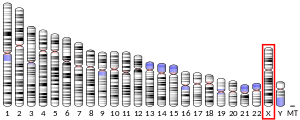PORCN
PORCN (porcupine homolog – Drosophila) is a human gene.[5][6] The protein is homologous to other membrane-bound O-acyltransferases.
Function
The protein encoded by this gene is an endoplasmic reticulum transmembrane protein involved in processing of wingless proteins such as WNT7A. It performs O-Palmitoleoylation of these proteins.[6]
Clinical significance
Mutations in this gene are associated with focal dermal hypoplasia.[7]
Mutations in PORCN are associated to Goltz-Gorlin syndrome.[8]
Ligands
Inhibitors
- WNT974 (LGK-974) - 1243244-14-5, researched for anti-cancer effects in Wnt-pathway sensitive tumours.[9] Also investigated for influencing cardiac tissue remodelling following infarction.[10]
IWP (1-4)
RXC004
gollark: Also, it might be hard to match each disk drive to a door or whatever.
gollark: They have a 256-block limit or something, I think.
gollark: I guess.
gollark: And how would that be contacted?
gollark: You'd obviously need to store the random string somewhere all the keycard-supporting things could access it.
References
- GRCh38: Ensembl release 89: ENSG00000102312 - Ensembl, May 2017
- GRCm38: Ensembl release 89: ENSMUSG00000031169 - Ensembl, May 2017
- "Human PubMed Reference:". National Center for Biotechnology Information, U.S. National Library of Medicine.
- "Mouse PubMed Reference:". National Center for Biotechnology Information, U.S. National Library of Medicine.
- Tanaka K, Okabayashi K, Asashima M, Perrimon N, Kadowaki T (July 2000). "The evolutionarily conserved porcupine gene family is involved in the processing of the Wnt family". European Journal of Biochemistry. 267 (13): 4300–11. doi:10.1046/j.1432-1033.2000.01478.x. PMID 10866835.
- Caricasole A, Ferraro T, Rimland JM, Terstappen GC (April 2002). "Molecular cloning and initial characterization of the MG61/PORC gene, the human homologue of the Drosophila segment polarity gene Porcupine". Gene. 288 (1–2): 147–57. doi:10.1016/S0378-1119(02)00467-5. PMID 12034504.
- Wang X, Reid Sutton V, Omar Peraza-Llanes J, et al. (July 2007). "Mutations in X-linked PORCN, a putative regulator of Wnt signaling, cause focal dermal hypoplasia". Nat. Genet. 39 (7): 836–8. doi:10.1038/ng2057. PMID 17546030.
- Brady PD, Van Esch H, Fieremans N, Froyen G, Slavotinek A, Deprest J, Devriendt K, Vermeesch JR (April 2015). "Expanding the phenotypic spectrum of PORCN variants in two males with syndromic microphthalmia". European Journal of Human Genetics. 23 (4): 551–4. doi:10.1038/ejhg.2014.135. PMC 4666577. PMID 25026905.
- Boone JD, Arend RC, Johnston BE, Cooper SJ, Gilchrist SA, Oelschlager DK, Grizzle WE, McGwin G Jr, Gangrade A, Straughn JM Jr, Buchsbaum DJ (Feb 2016). "Targeting the Wnt/β-catenin pathway in primary ovarian cancer with the porcupine inhibitor WNT974". Lab Invest. 96 (2): 249–59. doi:10.1038/labinvest.2015.150. PMID 26658453.
- Moon J, et al. (2017). "Blockade to Pathological Remodeling of Infarcted Heart Tissue Using a Porcupine Antagonist". Proc Natl Acad Sci U S A. 114: 1649–1654. doi:10.1073/pnas.1621346114. PMC 5320972. PMID 28143939.
This article is issued from Wikipedia. The text is licensed under Creative Commons - Attribution - Sharealike. Additional terms may apply for the media files.



